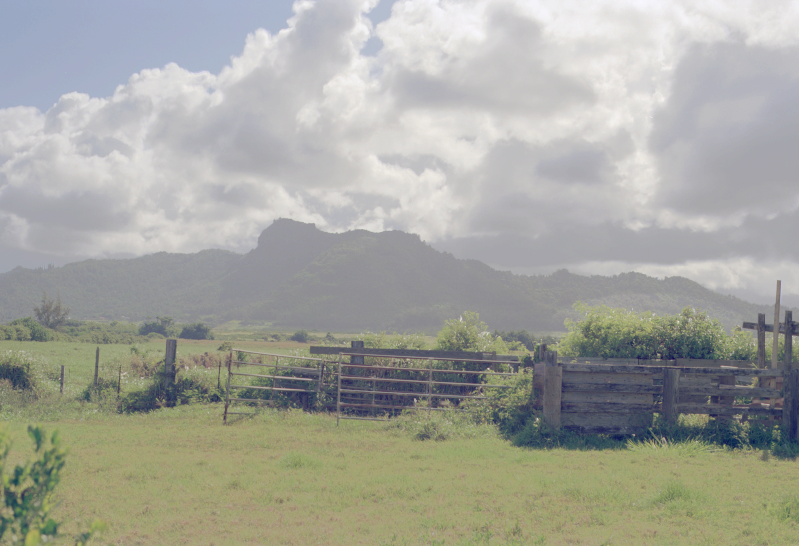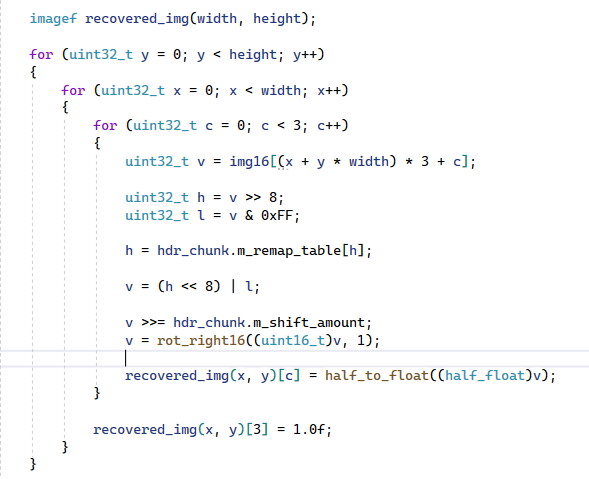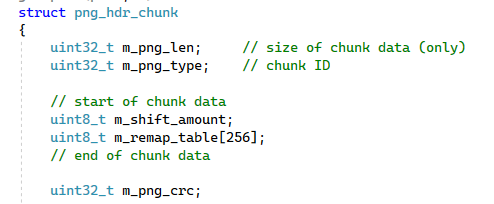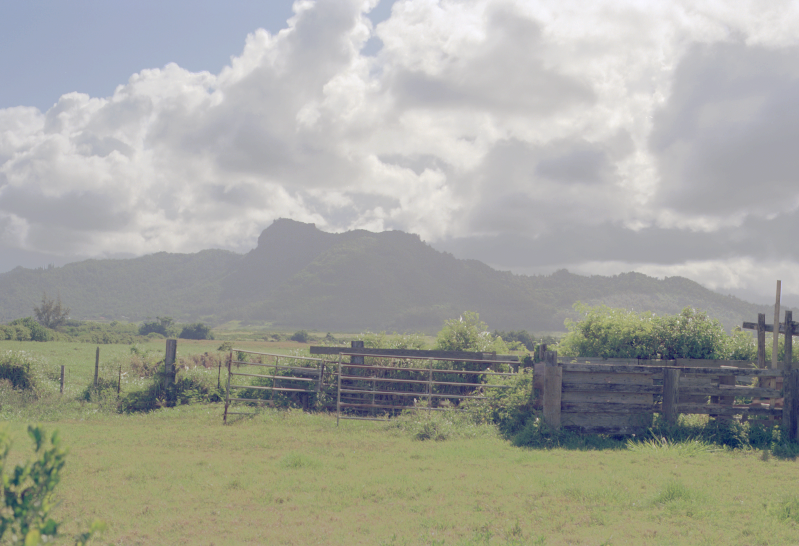- From: Chris Blume (ProgramMax) <programmax@gmail.com>
- Date: Mon, 13 Nov 2023 09:52:53 -0500
- To: Leonard Rosenthol <lrosenth@adobe.com>
- Cc: Richard Geldreich <rich@binomial.info>, public-png@w3.org
- Message-ID: <CAG3W2Kf2bPLWzr2n69bxiyyAT6BPcQkTPOR5+hJNbOBbAqB91A@mail.gmail.com>
My understanding is Rich is looking at data storage format for image processing, rather than final display. For example, a 12-bit int might be plenty for displaying a HDR image on the web. But it is not enough for a camera who's captured image will later be processed. This probably effects things like CICP markings, right? And if the data isn't actually a color image (infrared, motion vectors) then CICP definitely doesn't apply. On Mon, Nov 13, 2023, 9:34 AM Leonard Rosenthol <lrosenth@adobe.com> wrote: > Richard – I don’t understand. > > > > First off, HDR doesn’t mean anything without (at least) a CICP table. So > are you adding a standard cICP tag as well to your images? If you are > doing that, then at least you’re creating something that can be used in > other workflows. This is especially important as you think about how these > images will be composited with other HDR content, but in other formats…for > example, consider a web page with both one of your PNGs and a JPEG (using > the upcoming standard)… > > > > Second, what is the benefit to your published, but proprietary solution > over an open specification such as OpenEXR? Just that it happens to work > in PNG instead of some other format? From a wider industry perspective, I > don’t see the benefit and instead lots of downsides to users worldwide who > will now be confused why their images don’t work as expected. > > > > I’m certainly in favor of moving HDR forward – but IMO, we need to do it > consistently as an industry and not a series of “one offs”…. > > > > Leonard > > > > *From: *Richard Geldreich <rich@binomial.info> > *Date: *Monday, November 13, 2023 at 9:10 AM > *To: *Leonard Rosenthol <lrosenth@adobe.com> > *Cc: *public-png@w3.org <public-png@w3.org> > *Subject: *Re: backwards compatible half-float PNG test app > source+examples > > *EXTERNAL: Use caution when clicking on links or opening attachments.* > > > > > Before introducing another PNG-specific approach, we should see where > the industry is going and see if we can align with them first (which I > believe we can/should). > > > > We need 16-bit/component half float encoding support (not "color" - that's > a different problem) right now for our HDR codec work, so I'm going to open > source this couple hundred line HDR PNG solution with a small easy to > understand readme doc this week, using a ZLIB+Public Domain license. I'll > then work with PNG library authors to get it supported into their libs and > modify existing open source viewers to load HDR PNG's. > > > > We're already using half-float HDR PNG images for testing and development > in our codec work here. It's backwards compatible with all existing readers > and OS's, unlike .EXR, so it's a no brainer for us. > > > > Best regards, > > -Rich > > > > On Mon, Nov 13, 2023 at 8:35 AM Leonard Rosenthol <lrosenth@adobe.com> > wrote: > > Richard – very interesting work, thanks for sharing! > > > > However, it isn’t in line with where the rest of the industry is going > with respect to HDR imaging. Currently ISO TC 42, TC 171, TC 130, JTC 1/SC > 29 and the ICC are jointly working on a set of proposals for how to encode > various aspects of HDR data – including gain maps – into common formats and > technologies (including PNG). The groups will be meeting in Tokyo in > February for a full day working session to continue to move this work > forward. I believe that Chris Lilley will be there (perhaps remotely?) as > well as myself. > > > > We already have some complex logic in PNG with respect to color and HDR > (cICP vs. iCCP vs. gAMA vs sRGB vs ….). Before introducing another > PNG-specific approach, we should see where the industry is going and see if > we can align with them first (which I believe we can/should). > > > > Leonard > > > > *From: *Richard Geldreich <rich@binomial.info> > *Date: *Friday, November 10, 2023 at 11:05 PM > *To: *public-png@w3.org <public-png@w3.org> > *Subject: *Re: backwards compatible half-float PNG test app > source+examples > > *EXTERNAL: Use caution when clicking on links or opening attachments.* > > > > Here's how the half float pixel values are losslessly recovered from > 16-bit/component HDR PNG images in the "hdrpng" example code. This is the > entire decoding procedure. > > > > This code extracts the low and high bytes from the stored PNG's 16-bpp > pixels, remaps the high byte through the lookup table read from the "hdRa" > ancillary chunk (below), shifts right the 16-bit value from [0,15] bits > (this is typically 0, but for darker images it may be a small # of bits), > and then rotates the sign bit back into the MSB from the LSB of the 16-bit > value. This standard half float value can then be processed in an HDR > pipeline. > > > > The lossless encoder that takes half-floats and outputs 16-bit PNG values > is more complex, but not by much. It has to determine the shift amount by > examining all the half floats in the image and a high byte histogram, and > then compute a 256 entry lookup table using some sort of tone mapping > algorithm. The table must be computed in a way that results in no loss. > > > > > > On Fri, Nov 10, 2023 at 4:48 AM Richard Geldreich <rich@binomial.info> > wrote: > > If you want to see these example HDR .PNG's, unpacked to HDR .EXR files, > using an in-browser HDR viewer, I've unpacked them (using the example > hdrpng tool) to github here: > > https://github.com/richgel999/png16/tree/main/bin/unpacked > > > > The EXR viewer app (it's pretty good - I use it for testing on SDR > monitors): > > https://viewer.openhdr.org/ > > > > > > On Fri, Nov 10, 2023 at 4:34 AM Richard Geldreich <rich@binomial.info> > wrote: > > I've found a lossless and trivally invertible transform that takes > half-float HDR values (typically read from .HDR or .EXR images) and packs > them to 16-bit unsigned pixels that are completely compatible with existing > non-HDR aware PNG software. It uses a simple invertible and lossless global > tone mapping operator that operates directly on the half-float values. Old > readers view and see these PNG's as 16-bit PNG's (so usually 48bpp per > pixel for RGB). > > > > The high bytes are tone mapped so the 16bpp images appear passable to > existing readers. New readers can parse a small ~257 byte ancillary chunk > which contains a byte remapping table used to remap the high bytes of the > 16-bit components in the PNG image back to half-floats. (It's a little bit > more complex than this to deal with signed floats and very low values, but > that's the gist of it.) It's lossless for all valid half-float values > (normals, denormals, signed). I filter out any NaN's/Inf"s in this test. > > > > You can see a bunch of example 48-bpp PNG's packed from .EXR images in > this way here: > > https://github.com/richgel999/png16/tree/main/bin > > > > The C++ source to the example "hdrpng" tool is here. The example app > excluding image reading/writing is only ~450 lines of code. (It currently > compiles with VS 2022 under Windows - I'll add a Linux cmake file next.) > > https://github.com/richgel999/png16/ > > > > It uses the popular open source lodepng library, unmodified, to write and > read 16-bit PNG files and manipulate the ancillary "hdRa" chunk. > hdrpng supports packing and tone mapping .EXR images to .PNG, unpacking HDR > .PNG to .EXR, and an .EXR file comparison mode to verify that the half > float values can be 100% recovered from the PNG file with no loss. The tone > mapping in this example is automatic. > > > > I've tested the resulting 48bpp PNG files with pngcheck, Windows Explorer, > Chrome, Paint Shop Pro, several tools, and the Windows Photo viewer app. So > far, so good - they all look fine. > > > > Here are a couple example 48bpp PNG files. (Not sure what gmail will do to > them, but this is what they look like.) These are how existing PNG readers > view these HDR files. The half-float data is 100% preserved in these .PNG > files, so HDR capable viewers are able to retrieve the original half-float > pixels and do their own tone mapping or HDR processing. > > > > > > These PNG's validate successfully using pngcheck, because they are > completely standard PNG files that any reader can load: > > > >
Attachments
- image/png attachment: Kapaa.png

- image/png attachment: memorial.png

- image/png attachment: image.png

- image/png attachment: 04-image.png

- image/png attachment: 05-image.png

- image/png attachment: 06-Kapaa.png

Received on Monday, 13 November 2023 14:53:16 UTC